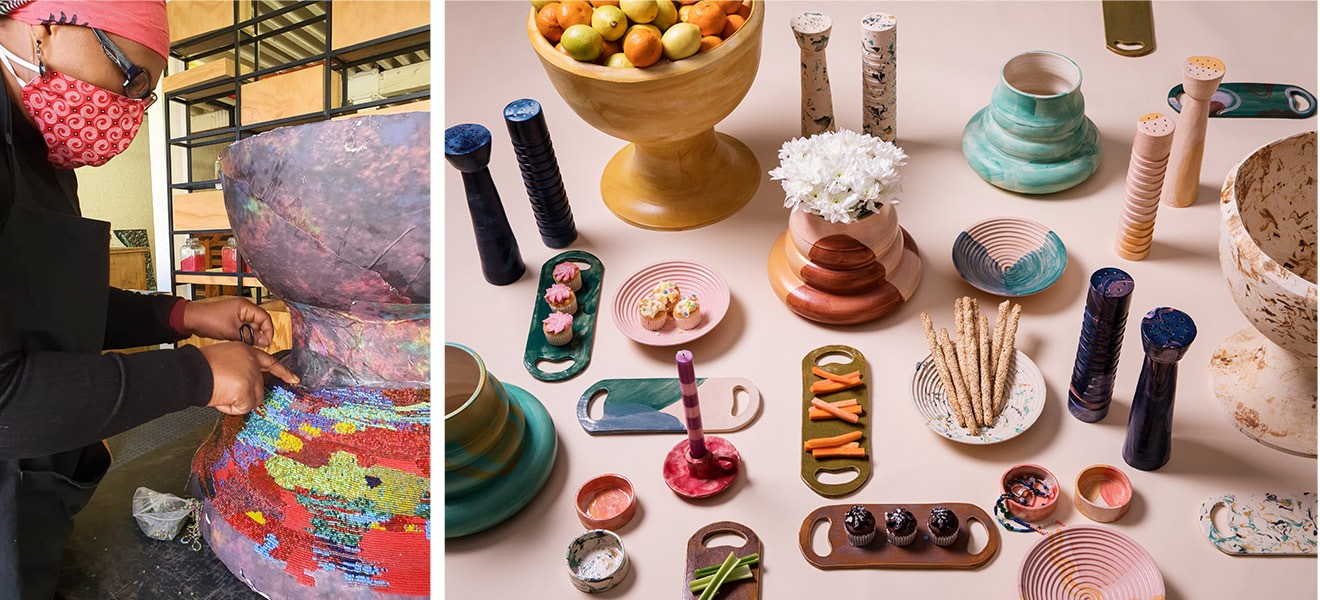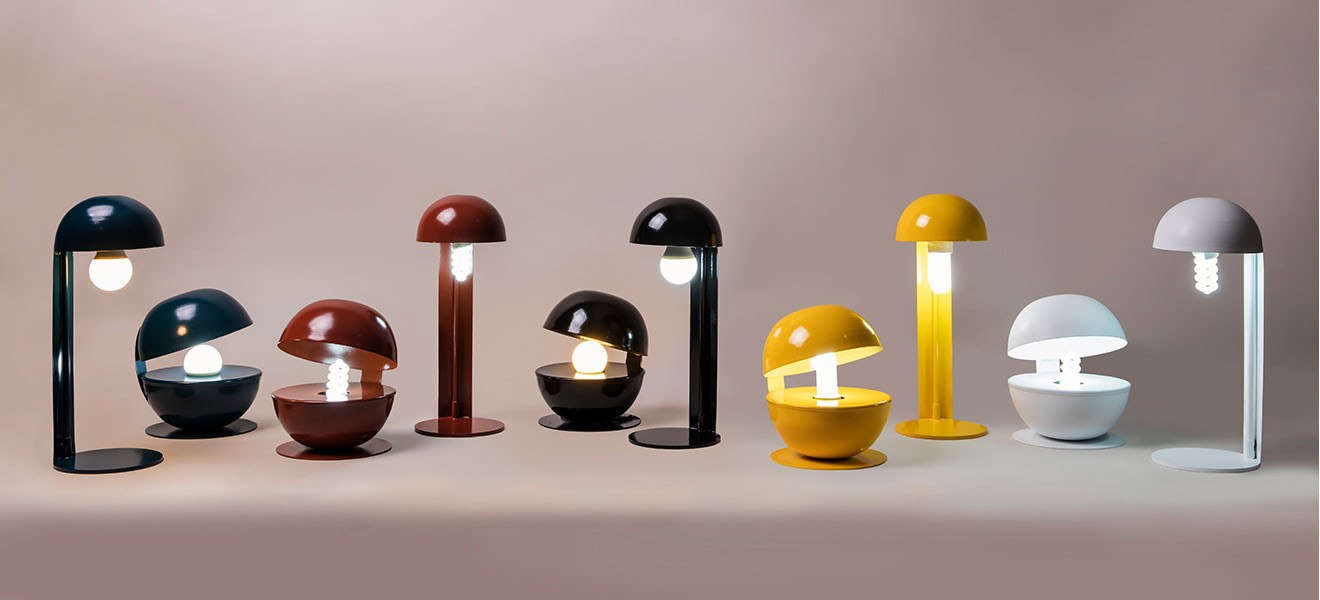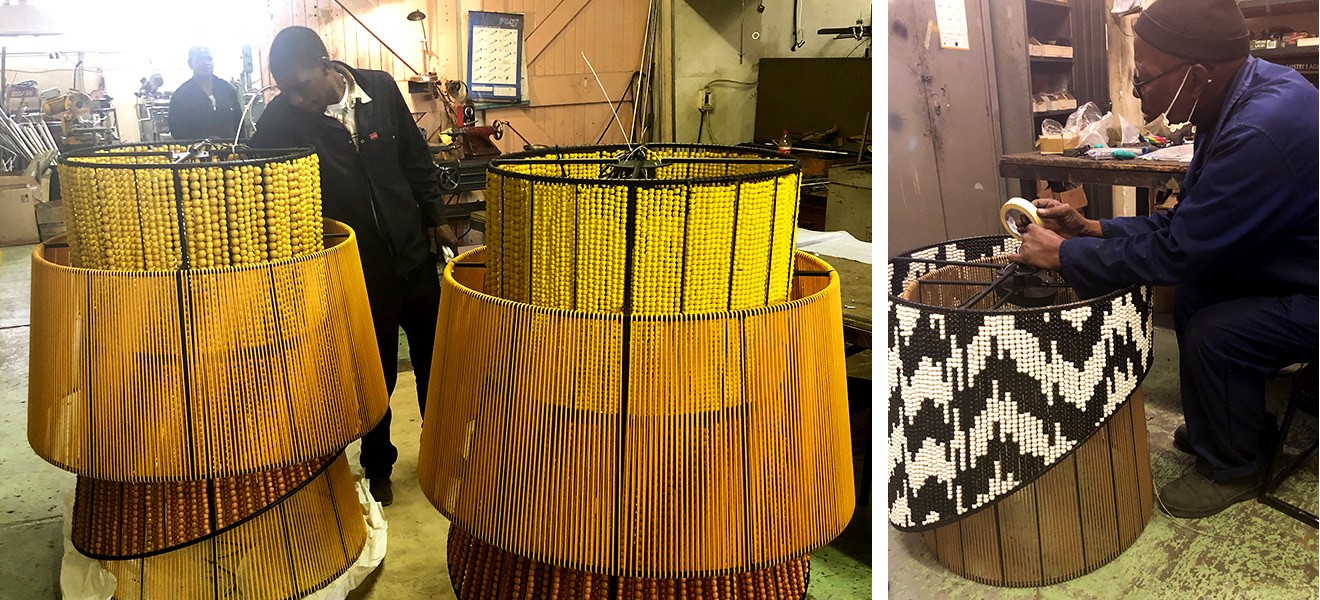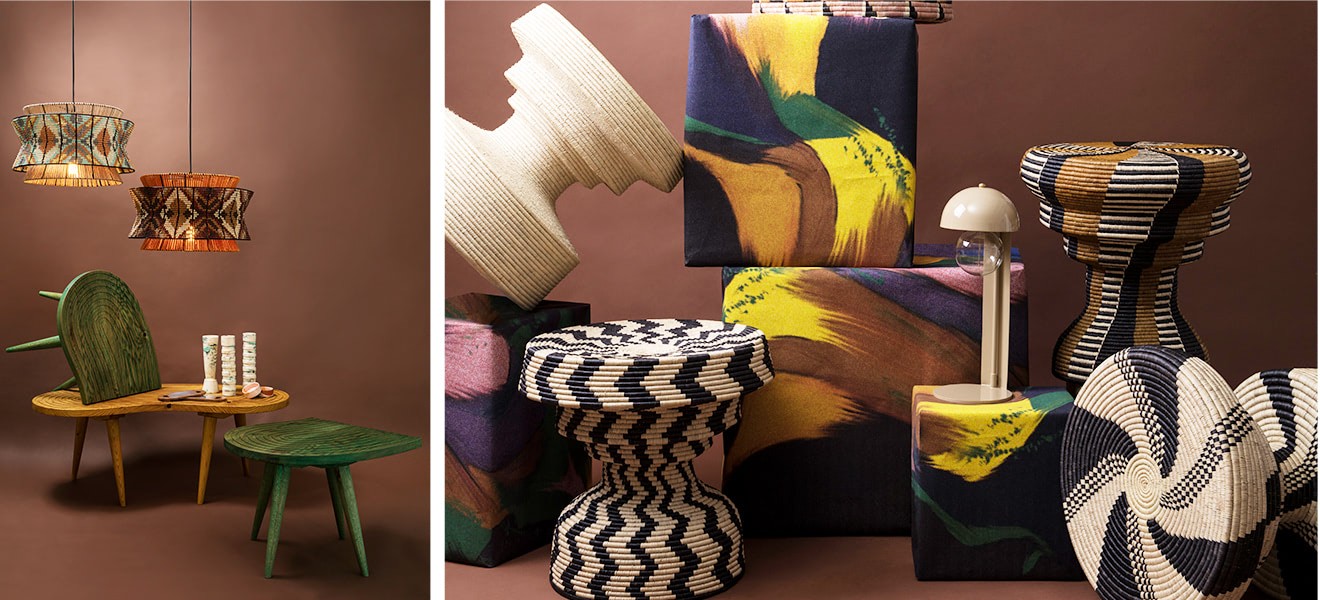Our tool for managing your permission to our use of cookies is temporarily offline. Therefore some functionality is missing.

MEET THE MAKER: THABISA MJO.
Thabisa Mjo, the designer behind Mash. T Design Studio, on craft, culture, humour, being included in international design museums and creating a sustainable design business.
Thabisa Mjo is one of a new generation of young South African designers to explode onto the design scene, making waves internationally, as well as locally. Her earliest successes were with lighting design, but recently her work has taken in everything from furniture to ceramic tableware.
Just five years ago, Mjo launched her first lighting designs in a collection called “Pieces of Me”, which won “Best of 100% Talent” at 100% Design South Africa in 2016. More awards followed, including the Design Indaba Most Beautiful Object in South Africa (MBOISA) award in 2018 for her now iconic Tutu 2.0 pendant light, which was inspired by xibelani: traditional skirts worn by Tsonga women. The design was first conceived as an entry in the Nando’s Hot Young Designer Talent Search, which she jointly won, and can now be seen in Nando’s restaurants around the world. She’s also exhibited her work internationally, notably in Milan, where she curated an exhibition of her own and other designer pieces at Milan Design Week, and at the Bonne Espérance Gallery in Paris.
After her striking pieces caught the eye of representatives of the Museum of Decorative Arts in Paris, they sought out examples of her work for the museum’s collection, which covers design from the Middle Ages through to modern times. Mjo’s Tutu 2.0 lamp and an eye-catching Mjojo cabinet are now in the company of legendary designers, such as Le Corbusier and Philippe Starck, and she has the distinction of being the first South African designer to have her work acquired for the museum’s permanent collection.
Apart from the obvious visual appeal of Mjo’s designs, there are a number of other things that make her work stand out from the crowd. Firstly, for her, design isn’t just about a look. “It’s basically about storytelling,” she says. Her designs consciously embody a narrative about local cultural heritage and the relationship between traditional and contemporary design. She has had the insight to recognise the potential in traditional local crafts and skills here in South Africa to be central to new expressions in modern contexts. “It’s about giving our cultural, traditional way of life [a new] medium,” she says.
She finds that on home turf, we tend to take local skills and crafts, like basketry and beading, for granted. “We’re so used to it,” she says. “We underestimate its value.” In fact, locally, many of us are so blasé about these skills that they’re in danger of being lost and forgotten with the last generation who learnt and practised them in their traditional forms.
Luxury brands around the world have returned to an emphasis on traditional craft, reviving many almost-extinct skills. “There’s been a renewed appreciation of crafts in the rest of the world,” Mjo points out. While she emphasises that she doesn’t see her own designs as part of a luxury-type brand, she recognises the importance of local crafts, and the role contemporary designers can play in keeping them alive.
This, for her, is not simply about preservation, but about finding new expressions for traditional skills that allow them to adapt and evolve in a contemporary world. “If they’re stuck in the past, then there will be a risk of them becoming redundant and dying out,” she says. But in collaborating with traditional crafters, she pushes them in new directions and creates opportunities for them to adapt and keep the skills vital, while also grounding contemporary culture and creating continuity in its relationship with its heritage.
I HAVE TO CONSTANTLY REMIND MYSELF THAT I AM IN THE BUSINESS OF DESIGN.
The beading in Mash. T’s Liz, Weavers Nest and Mummy pendant lights is done by women at the Boitumelo Sewing Project. The Hlabisa bench, a collaboration with fellow MBOISA alumnus Houtlander and Beauty Ngxongo, a master Zulu basket weaver from northern KwaZulu-Natal (whose work has been included in the Smithsonian Institution and the Metropolitan Museum of Art in New York) is a prime example of pushing a craft traditionally meant for one thing (basketry) in a new direction (flattening it out to form the backrest for the bench). The sculptural design of the bench itself is inspired by the silhouette of the hills where Ngxongo lives near the village of Hlabisa, which lent its name to the bench. (It’s also a hidden joke: “HL”, short for Houtlander, replaces the “Th” of Thabisa to give you Hlabisa… What are the chances!?)
But if you hadn’t already gathered from the light-hearted names and the playfulness of the designs themselves, this is no purist exercise in worthiness. It’s design that evokes a laugh as much as a warm emotional response.
“The idea of denim as African, and telling the story of denim on the African continent is a concept that is central to the brand, and to our design process,” he explains. “Denim is something that is often understood as definitive of American or Western culture, but TSHEPO wants to recognise and celebrate denim’s African roots. The cotton we use to construct our denim is from Zimbabwe and is recognised as some of the best cotton in the world. The story of denim is one intricately tied to colonialism, slavery and exploitation and this makes cotton unrefutably, painfully OURS as Africans. That’s why we want to use denim to tell these stories, to reposition denim in the hands of those who it truly belongs to – us.”
He reflects that the pandemic, while “definitely a challenge”, also consolidated his vision and sense of what he’s doing. “It also allowed us some really valuable time to reflect and reinforce our ethos as a company,” he says. “The pandemic taught us all, I think, the importance of community, and the power that we all have to make significant change. Particularly within the fashion industry, we’ve seen a big movement for supporting local brands.”
Mjo creates designs with personality, some as cute as others are beautiful. Her Pac-Man lamp, for example, as she’s been told, is “like a little character”. The Mjojo cabinet is a complex play on words – referencing the local JoJo water storage tanks that inspired its shape and playing on her name, Mjo. But it is also a play on the Xhosa word umjojo, which can be loosely translated to mean something that makes one shy away from attention. This word is the complete opposite of her intention with the cabinet, says Mjo, because the Mjojo “invites people to look at it because it is so wacky. It’s so interesting to me to see other people being intrigued by this wacky cabinet, because for me, it was just this outlandish idea that I had and, really, I wanted to satisfy my own curiosity to see if it could work.”
But both of these designs pick up on graphic or sculptural elements of contemporary commercial culture, playfully combining it with traditional design and pattern making.
Mjo points out, however, that as much as international exposure for her designs has an important role to play in the way local cultures are perceived, none of it can have any real lasting impact if it isn’t rooted in a sustainable business model. “It’s great that there’s a global appreciation, but I have to think of our country,” she says, and especially her role in keeping the crafters she collaborates with sustainable, too.
“I have to constantly remind myself that I am in the business of design,” she says. “How do we convert the interest to actual sales?”
Her newest work, a collection of ceramics and tableware, created in collaboration with Cape Town ceramicist Aléri Odendaal, titled “Presents from Joburg”, signals a slightly different direction for Mjo. She points out that before the pandemic, Mash. T was predominantly operating as a business-to-business enterprise, although individuals could still pick up her designs if they wanted to. “When corona struck, no one was building hotels or game lodges or restaurants,” she says. So she has found herself exploring new areas. In particular, she’s aimed to reach local audiences, diversifying her offering to make items smaller, more accessible (and easier to fit into more people’s houses) and affordable.
Not only has she developed her website and added online sales to the mix, but she is also distributing through channels such as Always Welcome in Hyde Park Corner in Johannesburg, a retail outlet focusing on the best of local design.
Getting her designs into more hands and homes also integrates their ethos into contemporary culture more thoroughly, completing the circle. Because as much as museums preserve design culture, being a part of everyday life is what gives them true currency.
Find out more at www.mashtdesignstudio.com.






